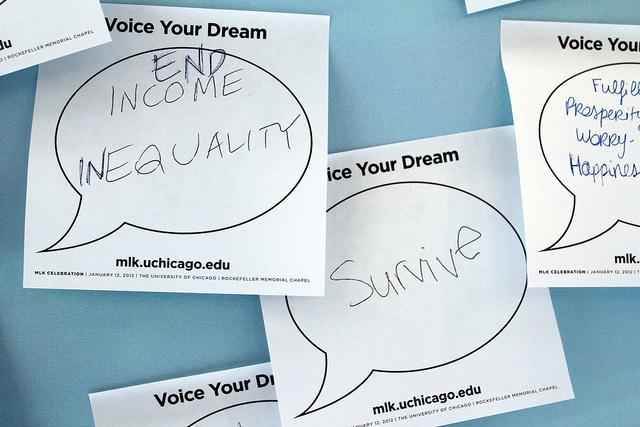Can Technology Help Fight Income Inequality?


It’s generally acknowledged that technology has had a major impact on the increase of income inequality for more than three decades, but can technology help reverse that trend?
That’s a big maybe at best, but George Mason University professor of economics Tyler Cowen, in a recent Economic View article in the New York Times, sketched out “some significant ways in which technology could reduce” income inequality.
Cowen said it’s worth exploring whether “market forces themselves might limit or reverse the trend.” For example, he continued, while computers have improved our lives in many ways, “they haven’t yet done much to make health care and education cheaper.”
That’s an arguable point, but he posited that, over the next few decades, that might change: “We can easily imagine medical diagnosis by online artificial intelligence, greater use of online competitive procurement for health care services, more transparency in pricing and thus more competition, and much cheaper online education for many students, to cite just a few possibilities.”
Another set of future gains, especially for lesser-skilled workers, Cowen said, “may come as computers become easier to handle for people with rudimentary skill. Not everyone can work fruitfully with computers now ... Our dynamic sector has concentrated its gains among a relatively small number of employees, thus leading to more income inequality.”
Then Cowen talked about a future that extends a growing employment category, “namely workers who team up with smart robots that require human assistance.” Hmmmm.
Cowen said a final of set of forces to reverse inequality could come from emerging economies, mainly China. “Perhaps we are living in a temporary intermediate period when America and many other developed nations bear a lot of the costs of Chinese economic development without yet getting many of the potential benefits. For instance, China and other emerging nations are already rich enough to bid up commodity prices and large enough to drive down the wages of a lot of American middle-class workers, especially in manufacturing.” This situation “will probably end.” Over the next few decades, Cowen wrote, “we can expect China, India and other emerging nations to supply more innovations to the global economy, including to the United States.” This will lead to “many good things” especially for low-income Americans.
Cowen’s conclusion? “Even if income inequality continues to increase in the short run, as I believe is likely, there exists a plausible and more distant future in which we are mostly much better off and more equal. The history of technology suggests that new opportunities for better living and higher wages are being created, just not as quickly as we might like.”
Oh please! This is simply a lot of debatable speculation based on a multitude of “ifs," “maybes," “coulds,” "probablies" and an almost ludicrous trust in a benign and distant market-based future in which everyone prospers if we simply remain patient. Utopia courtesy of the free market! Capitalism simply does not work that way: “The main vice of capitalism,” remarked Winston Churchill, “is the uneven distribution of prosperity.”
And a recent article in Fortune notes that “while inequality is a natural result of competitive, capitalist economies, there’s plenty of evidence that shows that extreme levels of inequality is bad for business … Unless your business caters to the richest of the rich, opportunities for real growth are scarce.”
It’s the extreme and growing levels of income and wealth inequality where Cowen’s piece fails to convince. Even if he’s right about the potential role of technology, will it be enough to stem the tide in a major way? He’s presenting the 2014 version of “trickle-down” economics.
Image credit: (End) Income (in)equality by Quinn Dombrowski via Flickr CC
Chick-fil-A Loses Legal Battle to Kale Enthusiast


A three-year legal saga came to a close last week, with a Vermont folk artist being allowed to continue using the phrase, "Eat More Kale." Chick-fil-A, a Georgia-based fast food chain that uses the slogan "Eat Mor Chikin," brought an intellectual property suit against Bo Muller-Moore, a Vermont resident and local food advocate. The U.S. Patent and Trademark Office granted Muller-Moore's request to trademark the phrase last Friday in a symbolic decision.
The Eat More Kale initiative is certainly a humble one, starting 13 years ago in Muller-Moore's home-based studio, before some of us had even heard of kale and how healthy it is. After he made a couple shirts for friends, others wanted one and the concept spread. He started selling the shirts at music festivals and farmers markets, until trouble sprang up in 2011.
When Muller-Moore applied to trademark the phrase, he was suddenly on Chick-fil-A's radar. The company coined the "Eat More Chikin" phrase in 1995, which is humorously said to have been initiated by cows to the interest of self-preservation. The advertising campaign has been highly successful and the backbone of the franchise's marketing efforts. Chick-fil-A's website explains: "These fearless cows, acting in enlightened self-interest, realized that when people eat chicken, they don't eat them. Today, the cows' herds have increased and their message reaches millions -- on television, radio, the Internet and the occasional water tower. Needless to say, Chick-fil-A fully endorses and appreciates the monumental efforts made by our most beloved bovine friends."
Apart from its advertising messages, Chick-fil-A is an interesting business in the way it operates. It is said to have a cult-like following among some customers and employees. All 1,800+ restaurants are closed on Sundays, yet it took the industry lead for average sales per restaurant at $2.7 million -- ahead of McDonald's at $2.4 million. This privately-held company also takes a unique approach to franchising; it has an very low franchise fee of $5,000 and is extremely selective in who operates its restaurants. The three-year legal battle may have also caused the company to receive some negative press, particularly for sustainable food enthusiasts.
Muller-Moore spoke in front of the Statehouse on Friday after being granted the trademark. "I've called Chick-fil-A's bluff on their cease-and-desist demands. I am not ceasing and desisting. I am thriving, thanks to people like you and thanks to Vermont and people from beyond."
But the fast-food chain's spokeswoman responded humorously: "Cows love kale, too."
Image Credit: Flickr/Mark Turnauckas
Sarah Lozanova is a regular contributor to environmental and energy publications and websites, including Mother Earth Living, Green Builder, Home Power, and Urban Farm. Her experience includes work with small-scale solar energy installations and utility-scale wind farms. She earned an MBA in sustainable management from the Presidio Graduate School and she resides in Belfast Cohousing & Ecovillage in Midcoast Maine with her husband and two children.
Contingency Planning for the Supply Chain


By Srini Vasan
Remember that old idea about how a butterfly flapping its wings in South America unleashes a crazy string of events that results in disaster elsewhere? Anybody who manages a supply chain understands the delicate interplay of events, and how one mishap can instantly derail your whole system. And how expensive the consequences can be.
Inbound Logistics found that 73 percent of companies they surveyed had experienced a disrupted supply chain. Almost a third of those companies took more than a month to recover.
Military coups, terrorist attacks and devastating events from Mother Nature happen. But making a contingency plan now will minimize the damage to your company and those it serves when the inevitable happens. Here are some steps you can take.
1. Map out your supply chain
To best anticipate possible problems, you need to understand your whole supply chain. If your business involves assembly parts shipped from China, for example, try to find out where the raw materials come from. How many different types of raw materials are used, and how do they get to the manufacturer? By what route does the manufacturer ship the parts to you?
2. Stay aware
Once you know what places and shipping routes are involved, stay up on the news. Sniff out possible events that could affect your company. Some things happen fast, such as a cave-in at a quarry. But other things develop more slowly, such as escalating conflict before a volatile election. Encourage any staff members who work directly with your overseas suppliers to ask for updates on developing storms or political situations. If you see trouble brewing, it’s time to fill in the details of Plans B and C.
3. Stock up on essentials
You can’t supply all of the people all of the time. But if you stockpile the essentials, you’ll keep customers happier and safer, depending on your business. For example, an American hospital will always want to maintain a large stock of antibiotics, but can probably risk running out of cobra antivenin.
4. Assess your risks
Study your supply chain. While all kinds of crazy things could potentially go wrong, some are likelier than others. California has earthquakes. Oregon has rain. If you live in Louisiana, hurricanes are a fact of life and will probably render roads impassable and knock out power. So maybe your company needs a generator.
Make a list of actions to take, depending on the emergency. And assign a responsible party to each.
5. Include your suppliers
Your suppliers need contingency plans, too. Work together to help each other come up with creative responses to big problems. For example, UPS shared their Trackpad technology with an animal rescue organization after Hurricane Katrina. During a future natural disaster, workers will be able to scan bar codes on collars to keep track of displaced animals. Together you can solve problems, while using contingency planning to increase trust and strengthen your business relationship.
6. Plan for alternate transportation
If you’re working with foreign suppliers, a storm overseas can mean a delayed shipment. Perhaps you’ll need to get part of your order by airfreight instead of waiting for that slow boat from China. Depending on the urgency, it might be worth going with the more expensive air shipping. Or finding backup suppliers in other parts of the world that you can call upon when necessary.
Contingency plans are also important for domestic shipments. What if a major derailment slows your rail shipment? Can you contract with a trucking company?
7. Audit your suppliers
How solid are your suppliers? If your foreign suppliers use the Supply Council Operations Reference model to manage their supply chain, that’s a good sign. Assess your suppliers’ risk for natural disasters, labor uprisings and geopolitical issues.
8. Clean house
Disruptive events are a good time to clean house. Are you still stocking SKUs that should have ridden off into the sunset? Might as well retire them now.
Then, back to contingency planning for the next disaster.
Image credit: Pantos Logistics - Sea Freight
Srini Vasan is the CEO of eShipGlobal, an on demand transportation management solution provider, which prides itself on bringing business applications to the market quickly and helping customers manage their transportation effectively. As CEO, Vasan is involved in business development and oversees technology infrastructure and software development.
Video: Sarah Endline of Sweetriot Talks Diversity at Net Impact '14


"To me, it's about bringing the best people to the table with differing opinions to try to make sure that we're always making the right business decision," Sarah Endline, cheif rioter (aka founder and CEO) of Sweetriot, said at the 2014 Net Impact conference.
"If you only have one point of view, I don't feel like you're going to get to the best solution."
As part of our Talking Diversity video series, Endline goes on to explain why diversity is important to Sweetriot -- a certified women-owned business that sources its cocoa from Latin America -- in this 90-second clip.
Sarah Endline is the chief rioter (aka founder and CEO) of Sweetriot. When Sarah is not climbing a cacao tree, she is found Latin dancing all over the globe or hanging out with family and friends. At 21, she won a stereo in a singing contest in Germany but never received the stereo - guess she wasn't really American Idol material. Nevertheless, Sarah loves to sing a cappella and has done so in Boston, NYC, Germany, Michigan, Seattle, and San Francisco.
Sarah has launched products, created brands, founded and run organizations, and worked many places like Yahoo!, Microsoft, the World Bank, AIESEC, and The National Foundation for Teaching Entrepreneurship (NFTE); Sarah loves the work at sweetriot best. Sarah has been an active member of many non-profit boards including those for NFTE, Harvard, UMichigan, and AIESEC. Sarah has an MBA from Harvard Business School and a BBA from The University of Michigan. (Go Blue!)
Image credit: Jean-luc Mège
Fund for Teachers Supports Sustainability One Teacher at a Time


By Carrie Caton Pillsbury
Sustainability widely refers to the endurance of products or processes. But for one nonprofit, the term applies to the profession of teaching. Fund for Teachers awards grants for pre-Kindergarten through 12th grade educators to keep them inspired, innovative and in the classroom. How educators choose to spend the national nonprofit's investment – well, that’s up to them.
Since 2001, 6,000+ teachers leveraged $22 million in Fund for Teachers grants into self-designed summer fellowships. The eduventures range from seminars across town to research spanning continents, whatever the teachers deem as relevant to their sustainability and students’ success.
Teachers are not eligible for the $5,000 individual or $10,000 team grants until their third year in the classroom for a reason: An estimated one-third of all new teachers leave after three years, and 46 percent are gone within five. Furthermore, the most frequently cited reasons new teachers leave are lack of professional development and not feeling valued. Fund for Teachers grants bridge this volatile gap, giving the respect and financial means to pursue knowledge outside classroom to motivate teachers to stay in the classroom.
Ironically, the theme of traditional sustainability as a fellowship focus continues to rise. For example:
- Michael Paoli (Ella Baker School - New York City) investigated aquaculture in France and the United Kingdom. All fall, 7th and 8th grade math/science students researched and constructed in school hallways a self-sustaining aquaponics system. Yesterday, students splashed blue tilapia into their tanks to raise edible fish and vegetation for an end-of-year community barbeque;
- Donna Gradel (Broken Arrow High School - Broken Arrow, Oklahoma) researched sustainable food sources in Meru, Kenya, with her grant and then challenged her students to design an aquaponics system for an orphanage there. Her AP Environmental Science class constructed multiple prototypes inside a vacant school closet, then raised $20,000 to transport and personally install the winning design onsite. Last month, Donna won a grant from MIT to facilitate students’ research on sustainable fish food using Kenya’s natural resources;
- Megan DeWitt (Monarch Academy Charter School - Glen Burnie, Maryland) explored recycling and trash management systems and environmental education in Guatemala. Inspired by a school there constructed with “eco bricks” (plastic bottles stuffed with inorganic trash, stacked like bricks and covered with cement), Megan and her students are now collaborating with local gardeners, waste management centers and school families to transform school trash into purposeful structures on campus; and
- Juliet Crupi (The Williamsburg Preparatory High School - Brooklyn, New York) volunteered with Worldwide Opportunities on Organic Farms utilizing permaculture techniques in Italy and Spain. She’s now sharing new hands-on farming practices through a new Urban Farming class for students with special needs to cultivate creative methods for growing healthy foods in an environmentally friendly closed system. This fall, her students have designed and implemented techniques in the school garden that increase water irrigation, decrease carbon levels and maintain a crop yield.
Biodiversity in the Amazon rainforests, gold mining in West Africa and microbial pathogens in India’s water supply characterize additional sustainability research teachers pursue on behalf of their students with these grants.
As the teachers become students themselves, the educational system becomes more viable. And sustainable teachers – fueled by meaningful experiences, projects and service – are the role models we want in front of every classroom, every day.
Teachers interested in designing their own professional development for summer 2015 have until January 29 to submit their application. For more information about Fund for Teachers, visit the nonprofit’s Facebook and blog.
Carrie Caton Pillsbury is Manager of Marketing & Communications at Fund for Teachers.
Jobs need protection as well as planet, says TUC


Unions have warned that they may not be able to support global climate change legislation if it fails to protect workers' jobs, says the TUC.
Although unions plan to support the United Nation's ambitious climate change treaty in Paris next year, they are concerned that as the world shifts to a low-carbon emission economy, policies and measures seem to have forgotten about the impact on the world's workforce.
'Just Transition' is a framework for a fair and sustainable shift to a low-carbon economy, proposed by unions and supported by environmental NGOs. The framework arose out of a concern that periods of economic restructuring in the past have often happened in a haphazard fashion, leaving ordinary workers and their communities to bear the brunt of the move to new ways of producing wealth.
The current draft treaty is missing text, agreed at the UN climate conference in Cancun in 2010, which urged “parties in implementing their policies and measures to promote a just transition of the workforce and the creation of decent work and quality jobs.”
TUC General Secretary Frances O'Grady said: “The labour movement is increasingly mobilizing to support an ambitious UN climate change treaty in Paris next year. We are conscious that all jobs are at risk without a commitment to emission reductions, adaptation, finance and technology. This is why we have always supported the UN process.
“However, the lack of thought being given to the possible effect on workers, added to the absence of references for the need for a just transition, has raised major concerns among the international trade union delegation in Lima.
“Governments previously agreed on the importance of climate change agreements addressing people's concerns about jobs, livelihoods and prosperity. The process in Lima appears to be is failing to live up to those promises.”
Picture credit: © Fintastique | Dreamstime.com - Abstract People In Pyramid Shape Photo
UPS and DHL awarded European label for sustainable transport


Green Freight Europe (GFE) has awarded UPS and Deutsche Post DHL with their ‘first leaf’ - an award given to companies that have shared CO2 data and information on policies, strategy and intentions to reduce CO2 emissions stemming from transport operations. Other companies, among them Heineken, IKEA, Krummen Kerzers and Aviko, were also awarded the first leaf.
The first leaf is part of a four-tier labelling programme by GFE that recognizes and benchmarks members based on their efforts and measures to further improve on CO2 reduction. UPS has been a member of GFE, the leading industry driven program to support companies in improving the environmental performances of freight transport in Europe, since 2009.
For the second year in a row, successful execution of UPS's global greenhouse gas (GHG) reduction strategy allowed the company to deliver more goods, while generating fewer emissions. In 2013, absolute carbon emissions decreased 1.5% from 2012, even as global shipping volume increased 3.9% during the same timeframe.
UPS currently utilises 3,647 alternative fuel and advanced technology vehicles worldwide. Since 2000, UPS’s alternative fuel and advanced technology vehicles have logged more than 560m kilometres and avoided using more than 130m litres of conventional gasoline and diesel. The savings put the company well on its way to reaching a goal of driving 1.6bn kilometres in alternative fuel and advanced technology vehicles by the end of 2017.
We are a founding member of Green Freight Europe as well as for the similar regional organization in Asia. Being amongst the first companies that have been awarded by Green Freight Europe proves that we are well ahead on our way to establish green logistics in our customers’ supply chains and foster the cooperation with our road subcontractors,” said Christof Ehrhart, Director Corporate Communications and Responsibility at Deutsche Post DHL.
Picture credit: © Sommersby  | Dreamstime com  - Man Delivering A A Parcel To Another 3d Man Photo
TriplePundit's Sustainable Holiday Gift Guide


When you have people and the planet on your mind, holiday shopping can be kind of a drag. Sure, you want to brighten your loved ones' holiday season, but not with yet another mass-produced trinket that's destined for the landfill before Valentine's Day.
Skip the trip to the big-box store, and gift your friends and loved ones with durable, useful items that align with your own values. To save you some time sifting through the ever-growing -- and often greenwashed -- list of "eco-products," this week we rounded up 15 sustainable presents that are sure to please everyone on your list. Holiday shopping = done.
1. Vegan cork tote
If you're in the mood to splurge for the ethical fashionista on your list, consider a stylish tote made of cork with vegan leather piping from Pelcor. The ladies of TriplePundit put this one through the test with a trip to the beach, and the straps even got a turn as a teething toy when it was carried as a diaper bag. This bag stood up elegantly even when it was packed to the gills, and the vegan leather is soft and pliable.
2. Levi's Commuter Jeans and Jackets
Stumped for the bike-lover on your list? Look no further than Levi's Commuter jeans and jackets, which are made to be worn while cycling city streets. Designed for and by cyclists, these stylish duds boast bike-ready features like waterproof protection, reflective outseams and adaptive technology that adjusts to the current climate and body temperature, so your favorite cyclist will always remain comfortable.
3. Wally One Living Wall Planter
Plants have been proven to boost indoor air quality and increase productivity. For an unusual and decorative way to bring the outdoors in, check out these clever living wall planters from Woolly Pocket. Made from 100 percent recycled plastic bottles, these planters are soft-sided, breathable and guaranteed not to harm your walls. If you're feeling generous, pick up a few so your favorite green thumb can arrange their planters in a modular design.
4. The ultimate rechargeable battery
For a smart stocking stuffer or white elephant gift, this rechargeable battery from USBCell is just what the doctor ordered. Just pop one of these batteries into your favorite gadget. When the power is tapped, simply charge it up at any USB port for an easy, on-the-go solution to disposable battery waste. Genius!
Price: $17.99 for a set of two
5. Nest Learning Thermostat
Help your favorite gadget-lover use smart technology to save energy all year round with a Nest Learning Thermostat. We've raved about the Nest more than a few times over the past few years, and for good reason. This smart little thermostat allows you to track your energy use and adjust the temperature remotely via Web or mobile.
6. Conscious Box
We love the super-convenient box subscription trend, and now there's a box that's tailor-made for the conscious shopper. Every month, your recipient will receive a box full of hand-picked, sustainable food, bath, beauty and household products. There are even vegan and gluten-free options available to suit everyone on your list. (There's no shame in subscribing yourself, too. After all, who doesn't love snacks?)
7. Recycled leather soccer ball and bag
After a major cabin retrofit, Southwest Airlines was left with beautiful leather and did not want to harm the environment by contributing to the growing corporate waste problem or destroying the textiles.
Enter Project Luv Seat, which took Southwest's old leather and partnered with conscious labels to turn it into brand new products. This ingenious idea is versatile enough to fit the kids, athletes and busy ladies on your list this holiday, and the creation of these products helped provide on-the-job training for disadvantaged workers.
Soccer ball price: $25 Bag price: $150
8. Bye Bye Standby Wireless Energy Control Starter Kit
Hate vampire power? So do we. And we're guessing the geek on your list does too. Give them a helping hand by complementing that fancy new gadget with this starter kit that lets energy-savers remotely cut power to any outlet. That's right: No more climbing behind furniture or tripping over power strips. (You're welcome.)
9. Evil Eye Arrow Bracelet
This pick is trendy enough to please every style-stalker on your list, and it also lends a helping hand to those in need. Sold in the Toms Marketplace, launched by Toms Shoes earlier this year to highlight other conscious labels, this bracelet funds a safe way to school for an orphan in Mexico for six months.
10. Home Gardener's Heirloom Seed Collection
Give your favorite foodie something sustainable this holiday season with this heirloom seed collection from Baker Creek Rare Seeds. Each set contains 20 full-sized packets of seeds and a helpful garden planner — all packaged in an attractive burlap bag with a drawstring closure. Varieties in are chosen to be productive in both Northern and Southern climates.
11. SunBell Solar Lamp and Phone Charger
You know that friend who can't seem to put down her smartphone? Now she'll never have to. The SunBell from Norwegian brand BRIGHT Products allows that serial status-updater to easily charge phones and other small devices while on-the-go using nothing but the sun's rays.
Each unit consists of a lamp shade and a removable fixture that holds the battery, the input/output for the solar cell and mobile phone, and a small lamp as an added bonus. 3p correspondent Tina Casey tested out the SunBell earlier this year and was pleasantly surprised by how easy, versatile and effective it was. "From now on, my cell phone is going to charge with 100 percent solar power," Casey wrote. Sounds like a win to us!
12. Aquazinger Infusion Water Bottle
Help your friends ditch fizzy drinks and bottled water all in one shot with this infusion water bottle from Zing Anything. Simply unscrew the bottom of the Zinger, add any combination of fruits, veggies and herbs, fill with water, and shake it up.
Seriously, infused water is the new soda. Do a simple Web search, and you'll find literally hundreds of options that are sure to help your recipients kick the sugary drink habit for good. As an added wellness bonus, each of these bottles is free of BPA and phthalates and comes in two designs to suit your recipient's busy lifestyle.
13. Trade as One Monthly Subscription Box
Give the best of Fair Trade every month with the Trade as One monthly subscription box. Each box contains a selection of 12 to 15 ethically-sourced pantry products that are as good for your recipient's health as they are for the people who made them. Delivered every three months, Trade as One boxes are seasonally themed and include a broad range of items from everyday staples to fun discovery items.
14. Handmade bow ties
It can be a challenge to surprise the hipster who has everything: He already owns a pair of thick-rimmed glasses and a beard comb. He even bought himself a pour-over coffee brewer last month. What's a holiday shopper to do?
These handmade bow ties from Dapper+Dash could be just what you're looking for. Handcrafted in Phoenix, Arizona from upcycled vintage clothing and other textiles, they're the perfect marriage of style and sustainability.
15. Offgrid Solar Backpack
Perfect for your busiest buddies, the Offgrid Solar Packpack makes solar charging so simple, there's no excuse not to do it. Voltaic Systems offers a full line of portable solar cells, as well as backpacks and messenger bags, but the Offgrid is its most versatile design: The solar pocket is removable and can be attached to other bags or anything else as it charges.
The Offrid can charge handheld devices like smartphones, MP3 players and tablets. If you're willing to splurge, the slightly pricier Array Backpack puts out enough juice to power up a laptop, too.
Image credit: Pexels
Policy Points: Three Signs of Hope from 2014


By Zach Bernstein
As 2014 reaches its final days, it’s worth looking back at what this year brought us. Not all of it was good – indeed, major priorities for sustainable business leaders stalled in Congress.
But when it came to the states, action on a pair of issues gained even more momentum. And a third which failed in Congress – and suffered a setback from the Supreme Court – still offers hope that a solution can be found. For a year that didn't exactly inspire confidence in policy-making generally, it was actually a better year for sustainable policy than one might think.
1. Minimum wage
While Congress dithered on raising the federal minimum wage to $10.10 an hour, states and voters decided they were not going to wait. Every state that held a minimum wage ballot initiative – Alaska, Arkansas, Nebraska and South Dakota, as well as a nonbinding measure in Illinois – passed it. Another 10 states, plus Washington, D.C., passed increases through their legislatures, while nine more were in line to have their minimum wage floors increase due to indexed increases.
Despite concerns that minimum wage increases would be bad for business, national, scientific polling from the American Sustainable Business Council (ASBC) and Business for a Fair Minimum Wage (BFMW) released earlier this year found that 61 percent of small business owners supported raising the minimum wage to $10.10 an hour (PDF). The reason for this is that increasing pay for workers spurs consumer demand, giving businesses increased revenue – and that’s before taking into account lower employee turnover and higher productivity.
And as evidenced by the range of states taking action on the minimum wage – a good mix of Democratic- and Republican-leaning states – this issue is far less partisan than Congress makes it out to be. Expect the states to keep moving forward with more victories like these in the months ahead.
2. Good workplace
Two pieces of federal legislation dealing with paid leave stalled in Congress this year. One was the FAMILY Act, sponsored by Sen. Kirsten Gillibrand (D-NY) and Rep. Rosa DeLauro (D-CT), which would have provided paid time off to recover from pregnancy or spend time with an adopted child, or to care for a family member with a serious medical condition. Work also continued on the Healthy Families Act, sponsored by Sen. Tom Harkin (D-IA), which would have given employees one hour of paid time off for every 30 hours worked.
Again, activities at the state and local level saw more success. All four ballot initiatives on paid leave passed – a statewide initiative in Massachusetts (which became the third state to require paid leave), and citywide initiatives in Trenton and Montclair, N.J.; and Oakland, Calif. These followed the passage of eight other laws earlier this year, including a statewide law in California.
As with the minimum wage, paid leave benefits businesses, leading to more productive employees who are less likely to seek jobs elsewhere. And, while 2014 was a good year for making that case – especially having forward-thinking business leaders join in – more work is needed for this narrative to prevail. Again, paralleling the minimum wage, though, the country appears to be far ahead of its representatives on paid leave.
3. Campaign finance reform
Here, the news was decidedly more mixed. On the one hand, the Supreme Court handed down its decision in McCutcheon v. FEC, eliminating the aggregate limits on campaign contributions. So, while contributions to individual candidates, committees or PACs are still capped, donors can now contribute the legal maximum to as many of them as they wish. Previously, election law limited how much donors could contribute in total.
However, the Senate also held a historic vote on a new amendment to the United States Constitution which would have overturned the Supreme Court’s decision in Citizens United v. FEC. While it failed to meet the 67-vote threshold needed to hold the vote, more than half of the Senate showed support for strong campaign finance regulations – something most Americans, and most small business owners (PDF), support.
Most small businesses don’t have the resources, or the desire, to spend huge sums of money on political campaigns. Those businesses that do often represent legacy industries with different policy opinions and desires than most Americans, or even American companies. Their contributions skew American policymaking – and in the process, contribute heavily to public disaffection with the political process.
The idea that businesses want this ability to spend without limits on elections might make for a good soundbite, but as with perceived opposition to paid leave and increasing the minimum wage, it just isn’t true. Once more, Congress lags behind – but not by much.
So, 2014 may not have been the best year for sustainable policy, but as these issues show, there could be more victories to come. Especially if sustainably-minded business leaders make their voices heard and build on the gains we’ve made.
Image (cropped): Flickr/danmoyle
Zach Bernstein is the Manager of Research and Social Media for the American Sustainable Business Council. Policy Points is produced by the American Sustainable Business Council. The editor is Richard Eidlin, Vice President – Public Policy and Business Engagement.
Tar Sand Companies’ Future CO2 Emissions Could Increase Five-Fold


Supporters of the Keystone Pipeline and Canada’s tar sands development like to call their product “ethical oil,” but plenty of their opponents question whether digging up massive amounts of the earth’s surface is really “ethical.” Those who question whether churning tar sands into fuel, the most energy-intensive fossil fuel to refine, is a wise long-term policy will have more ammunition due to a report Fossil Free Indexes recently released. It could give potential investors in tar sands companies second thoughts about buying their equities.
According to this New York-based research group, which provides data to support ethical investing, the top 20 companies that have invested in the Canadian tar sands have increased their potential carbon dioxide emissions by more than five times the past 10 years. The FFI came up with this list based on its most recent Carbon Underground Tar Sands 20, which is comprised of the largest of the 200 public coal, oil and gas companies based on their reported reserves.
The companies with the five highest embedded carbon emissions, based on their total tar sands reserves, should not be surprising: ExxonMobil, Suncor Energy, Imperial Oil, Canadian Natural and Shell top the list. And out of the total potential emissions the companies with the 20 largest tar sands reserves are holding, these top five are storing a whopping 57 percent of CO2 that could eventually be released into the earth’s atmosphere.
Furthermore, FFI’s methodology only counted potential CO2 emissions based on reserves these companies publicly disclose. They do not include emissions from other processes involved in the development of tar sands, including extraction, refining, transport and distribution. Consider the fact that 80 percent of Alberta’s tar sands are too deep to mine and therefore require steam to melt the ground containing the tar (or bitumen) that is eventually converted into oil. The long term environmental impact of harvesting these reserves goes beyond the carbon emitted once the resulting fuel is consumed.
So what is the point of FFI distributing this information? This organization is looking at it from a business point of view rather than from a political or environmental perspective. At a time when more investors are interested in companies with a strong record of corporate responsibility, environmental stewardship and ethics to include in their portfolios, FFI makes the case that its index of companies, which scrub out large carbon emitters from the S&P 500, reveals an overall performance virtually indistinguishable from the overall S&P 500. For foundations, universities and other organizations seeking to divest from companies involved in tar sands extraction, the FFI just offered them compelling data to help them make that decision.
After a year in the Middle East and Latin America, Leon Kaye is based in California again. Follow him on Instagram and Twitter. Other thoughts of his are on his site, greengopost.com.
Image credit:Wikipedia